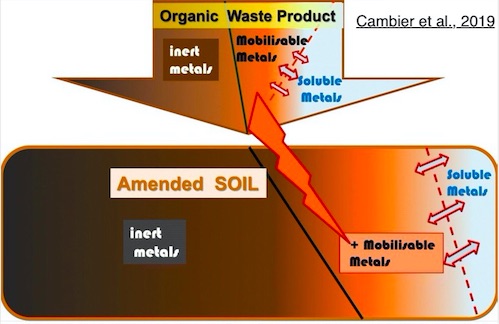PROLEG
|
Article scientifique Cambier P., Michaud A., Paradelo R., Germain M., Mercier V., Guérin-Lebourg A., Revallier A., Houot S. Trace metal availability in soil horizons amended with various urban waste composts during 17 years – Monitoring and modelling Science of The Total Environment, 2019, 651, 2961-2974. Recycling organic residues in agrosystems presents several benefits but faces the question of contaminants, among them a few trace metals which eventually accumulate in soils following regular applications of organic waste products (OWP) and represent an ecological risk. The increase of total trace metal contents in amended topsoils can be predicted by a mass balance approach, but the evolution of their available fractions is a more intricate issue. We aimed at modelling this evolution by using the dataset of a long-term field experiment of OWP applications (manure and three urban waste composts). Two operationally-defined fractions of 6 trace metals have been quantified in the OWP and amended topsoils between 2002 and 2015: the soluble and potentially available metals, extracted in 0.01 M CaCl2 and 0.05 M EDTA solutions, respectively.The potentially available metals have progressively increased in amended topsoils, at rates depending on elements and types of OWP. For Zn, these increases corresponded in average to inputs of potentially available Zn from OWP. But the soil stocks of potentially available Cu increased faster than from the inputs of EDTA-extractable Cu, showing linear regression slopes between 1.4 and 2.5, depending on OWP type. The influence of OWP has been provisionally interpreted in the light of their efficiency to increase soil organic matter and their inputs of reactive oxides. Soluble copper has increased with repeated amendments. But soluble cadmium, nickel and zinc have generally decreased, as they are influenced by changing soil variables such as pH and organic matter. Statistic models were used to unravel the relationships between soluble and EDTA-extractable metals and other soil variables. For Cu, the most satisfactory models just relate soluble and potentially available Cu. Developing such models could contribute to predict the long-term effects of a precise scenario of agricultural OWP recycling upon available trace metals in soils. Keywords: Organic amendment, Soil quality, Heavy metal, Diffuse contamination, Soluble metal, Long-term field experiment A retrouver ici: https://doi.org/10.1016/j.scitotenv.2018.10.013  |